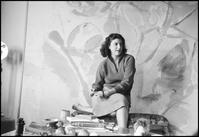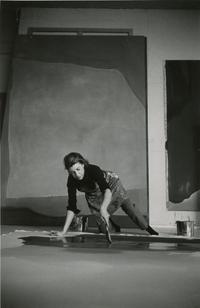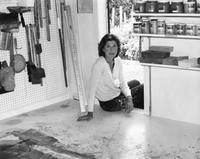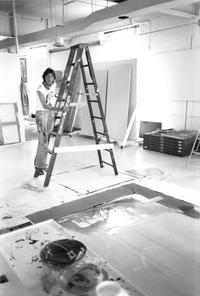
Frankenthaler in front of
Mountains and Sea, 1952,
in her West End Avenue apartment, New York, 1956.
Photograph by Burt Glinn / Magnum Photos
Helen Frankenthaler, A Brief Biography
Helen Frankenthaler (1928-2011), whose career spanned six decades, has long been recognized as one of the great American artists of the twentieth century. She was eminent among the second generation of postwar American abstract painters and is widely credited for playing a pivotal role in the transition from Abstract Expressionism to Color Field painting. Through her invention of the soak-stain technique, she expanded the possibilities of abstract painting, while at times referencing figuration and landscape in unique ways. She produced a body of work whose impact on contemporary art has been profound and continues to grow.
Frankenthaler was born on December 12, 1928, and raised in New York City. She attended the Dalton School, where she received her earliest art instruction from Rufino Tamayo. In 1949 she graduated from Bennington College, Vermont, where she was a student of Paul Feeley. She later studied briefly with Hans Hofmann.

Frankenthaler in her East 83rd Street studio, New York, 1969.
Photograph Ernst Haas / Getty Images
Frankenthaler’s professional exhibition career began in 1950, when Adolph Gottlieb selected her painting Beach (1950) for inclusion in the exhibition titled Fifteen Unknowns: Selected by Artists of the Kootz Gallery. Her first solo exhibition was presented in 1951, at New York’s Tibor de Nagy Gallery, and that year she was also included in the landmark exhibition 9th St. Exhibition of Paintings and Sculpture.
In 1952 Frankenthaler created Mountains and Sea, a breakthrough painting of American abstraction for which she poured thinned paint directly onto raw, unprimed canvas laid on the studio floor, working from all sides to create floating fields of translucent color. Mountains and Sea was immediately influential for the artists who formed the Color Field school of painting, notable among them Morris Louis and Kenneth Noland.
As early as 1959, Frankenthaler began to be a regular presence in major international exhibitions. She won first prize at the Premiere Biennale de Paris that year, and in 1966 she represented the United States in the 33rd Venice Biennale, alongside Ellsworth Kelly, Roy Lichtenstein, and Jules Olitski. She had her first major museum exhibition in 1960, at New York’s Jewish Museum, and her second, in 1969, at the Whitney Museum of American Art, followed by an international tour.
Frankenthaler experimented tirelessly throughout her long career. In addition to producing unique paintings on canvas and paper, she worked in a wide range of media, including ceramics, sculpture, tapestry, and especially printmaking. Hers was a significant voice in the mid-century “print renaissance” among American abstract painters, and she is particularly renowned for her woodcuts. She continued working productively through the opening years of this century.

Frankenthaler in her studio, Shippan Point, Stamford, Connecticut, 1983
Photograph by Cora Kelley Ward
Frankenthaler’s distinguished, prolific career has been the subject of numerous monographic museum exhibitions. The Jewish Museum and Whitney Museum shows were succeeded by a major retrospective initiated by the Modern Art Museum of Fort Worth that traveled to The Museum of Modern Art, New York, the Los Angeles County Museum of Art, and the Detroit Institute of Arts, MI (1989); and those devoted to works on paper and prints organized by the National Gallery of Art, Washington, D.C. (1993), among others.
Select recent important exhibitions have included Painted on 21st Street: Helen Frankenthaler from 1950 to 1959 (Gagosian, NY, 2013); Making Painting: Helen Frankenthaler and JMW Turner (Turner Contemporary, Margate, UK, 2014); Giving Up One’s Mark: Helen Frankenthaler in the 1960s and 1970s (Albright-Knox Art Gallery, Buffalo, NY, 2014–15); Pretty Raw: After and Around Helen Frankenthaler (Rose Art Museum, Brandeis University, Waltham, MA, 2015); As in Nature: Helen Frankenthaler, Paintings and No Rules: Helen Frankenthaler Woodcuts (The Clark Art Institute, Williamstown, MA, 2017); Abstract Climates: Helen Frankenthaler in Provincetown (Provincetown Art Association and Museum, MA, 2018, traveled to Parrish Art Museum, Water Mill, NY, 2019); and Pittura/Panorama: Paintings by Helen Frankenthaler, 1952–1992 (Museo di Palazzo Grimani, Venice, 2019), the first presentation of the artist’s work in Venice since its 1966 appearance at the 33rd Venice Biennale.

Frankenthaler in her studio, Canal Street, Stamford, Connecticut, 1987
Photograph by Robert Grobengieser
From November 2019 – November 2021, Tate Modern, London, presented a display of five works from the first three decades of Frankenthaler’s career, featuring four loans and one recently gifted work from the Helen Frankenthaler Foundation.
Frankenthaler has been the subject of three major monographs: Frankenthaler, by Barbara Rose (1972); Frankenthaler, by John Elderfield (1989); and Frankenthaler: A Catalogue Raisonné, Prints 1961–1994, by Suzanne Boorsch and Pegram Harrison (1996), as well as numerous scholarly articles on her work by renowned art historians, curators, and critics. The authors in her many substantial exhibition catalogues include Carol Armstrong, Carl Belz, Julia Brown, E.A. Carmean, Jr., Bonnie Clearwater, Ruth Fine, Judith Goldman, Eugene C. Goossen, Pepe Karmel, Frank O’Hara, Francine Prose, and Karen Wilkin.
In 2015 Gagosian published "The heroine Paint": After Frankenthaler, edited by art historian and curator Katy Siegel, which explores Frankenthaler’s painting and expands its focus to include the immediate social and artistic context of her work, then traces artistic currents as they move outward in different directions in the ensuing decades. The book collects six scholarly essays, six short texts from contemporary artists, and reprints of historical writing.
Frankenthaler was the recipient of numerous honorary doctorates, honors, and awards. She received the National Medal of Arts in 2001; served on the National Council on the Arts of the National Endowment for the Arts from 1985 to 1992; was a member of the American Academy of Arts and Letters (1974–2011), where she served as Vice-Chancellor in 1991; and was appointed an Honorary Academician of the Royal Academy of Arts, London, in 2011.
Important works by Frankenthaler may be found in major museums worldwide.
* * *

Frankenthaler seaside, Shippan Point, Stamford, Connecticut, 1982
Photograph by Inge Morath © The Inge Morath Foundation / Magnum Photos
